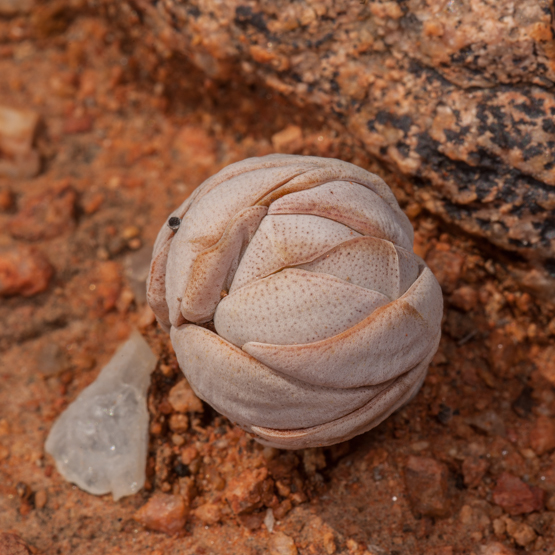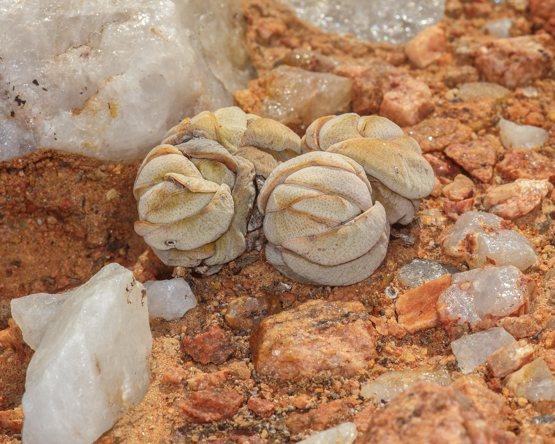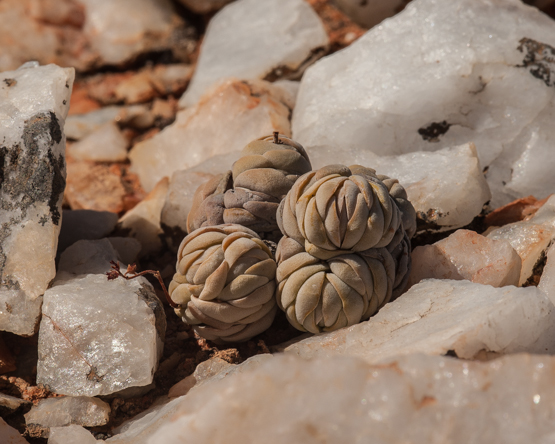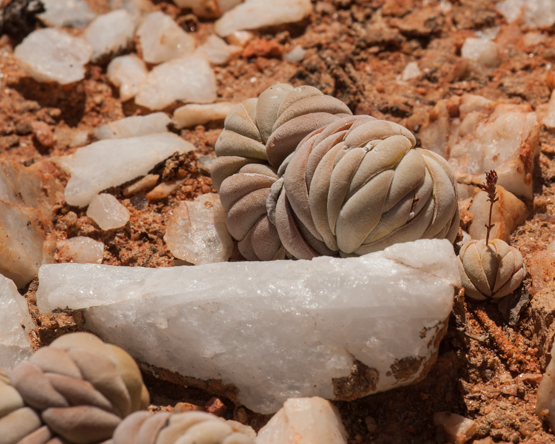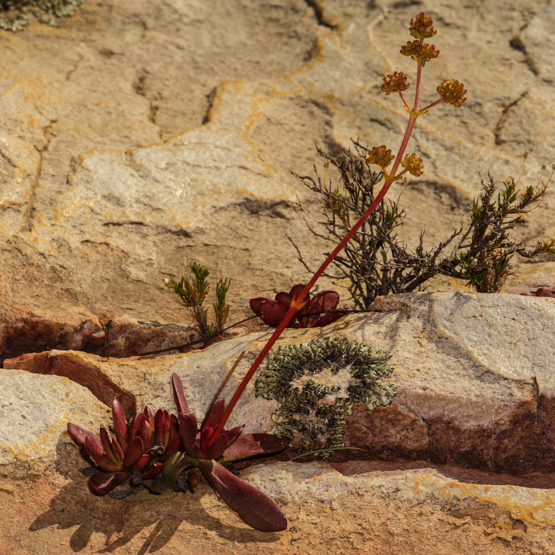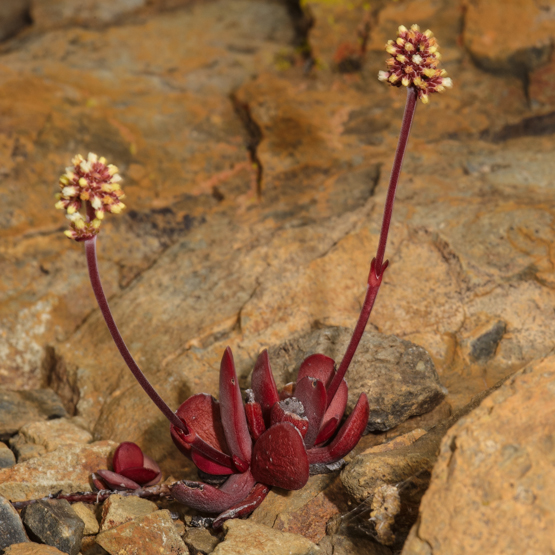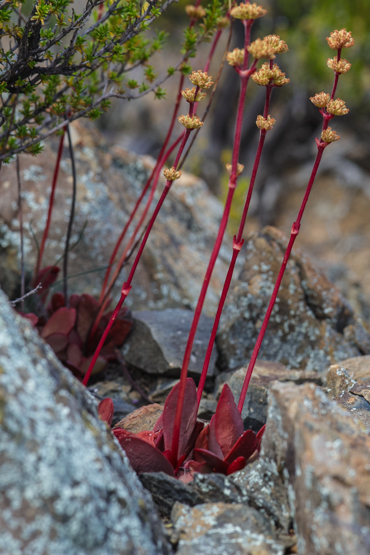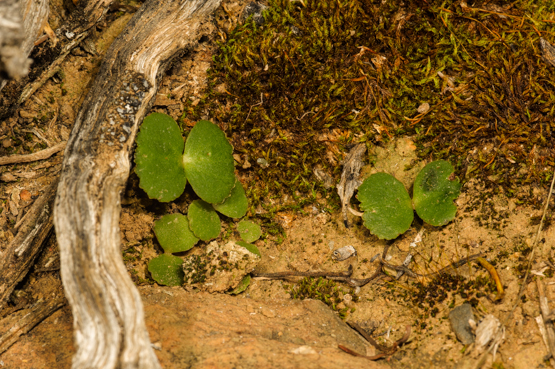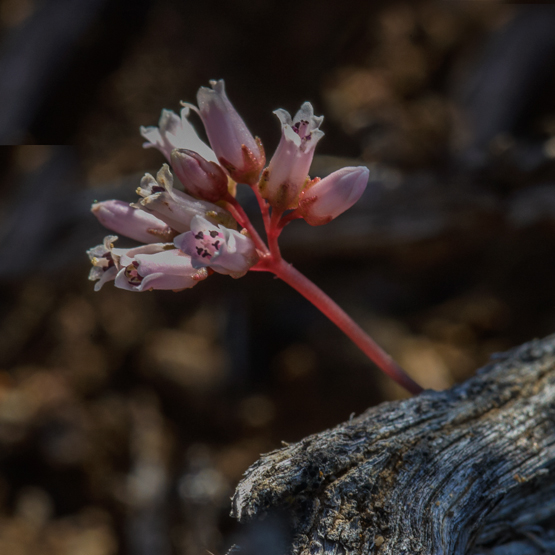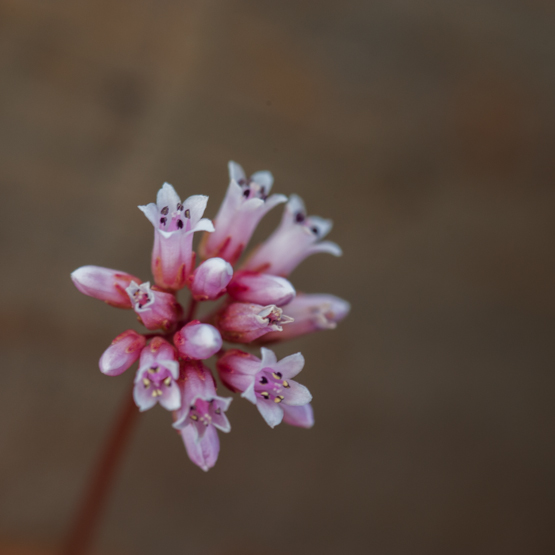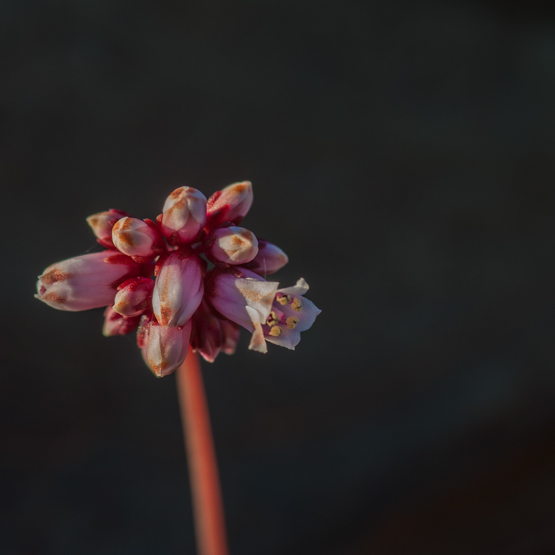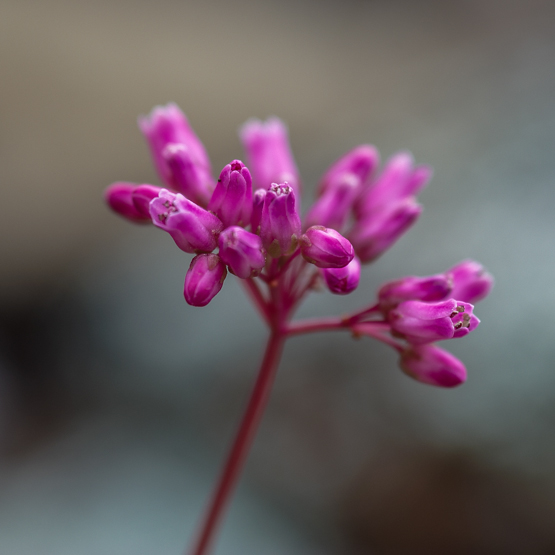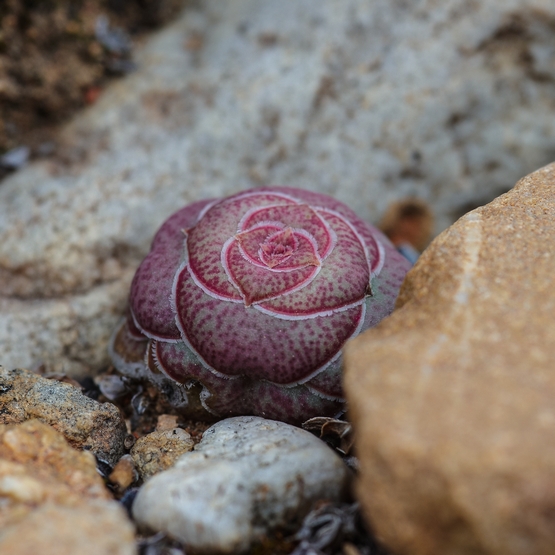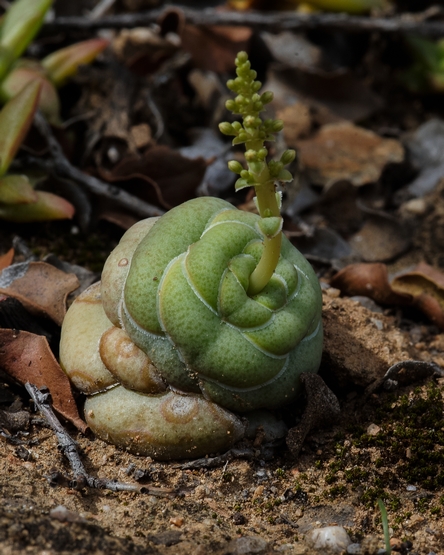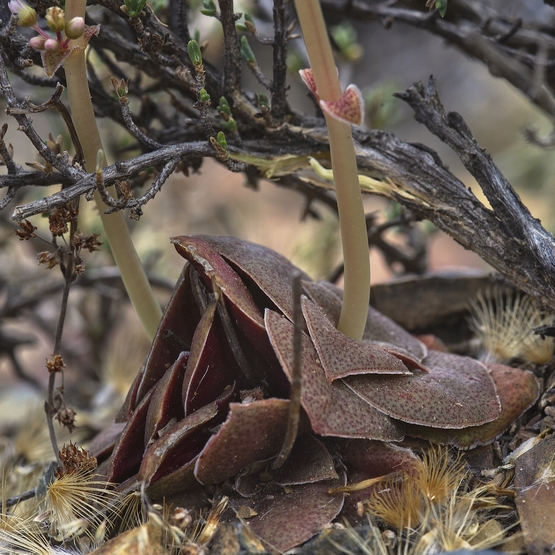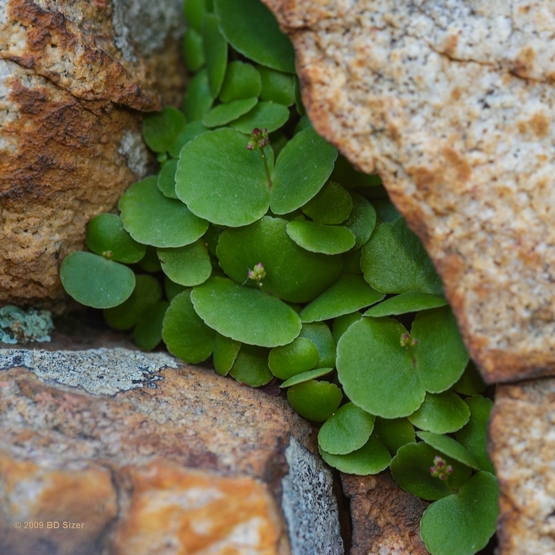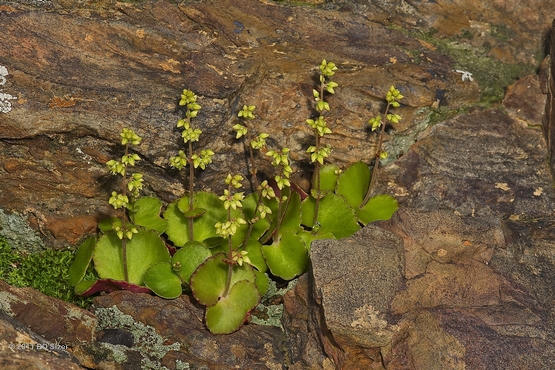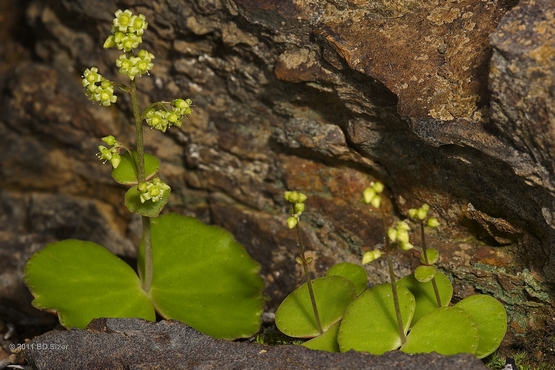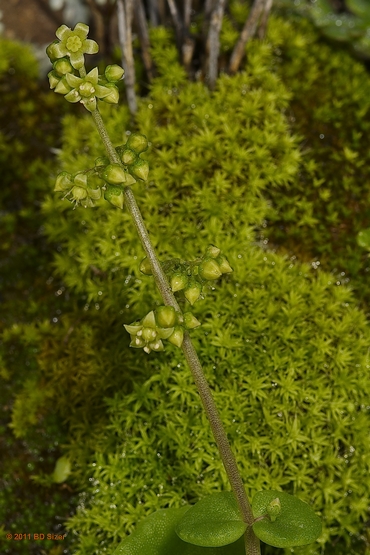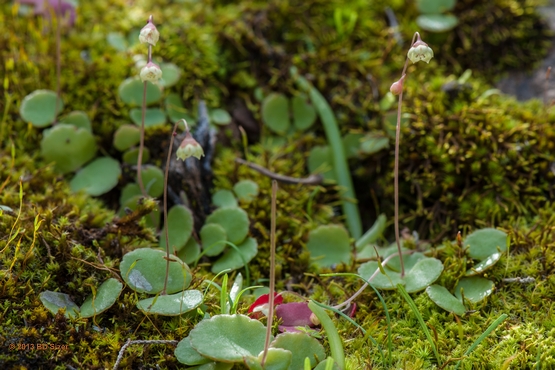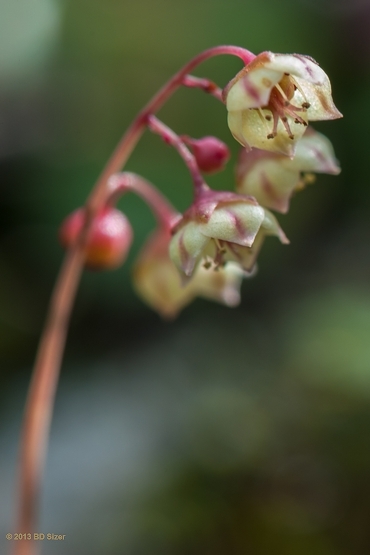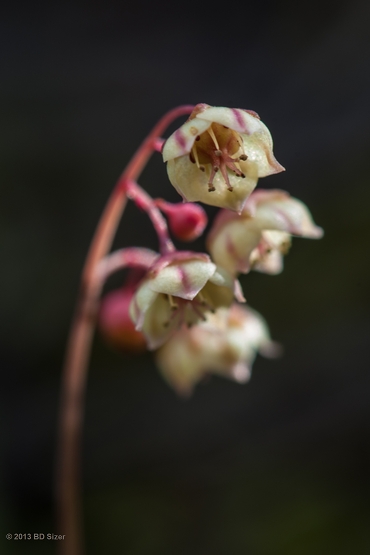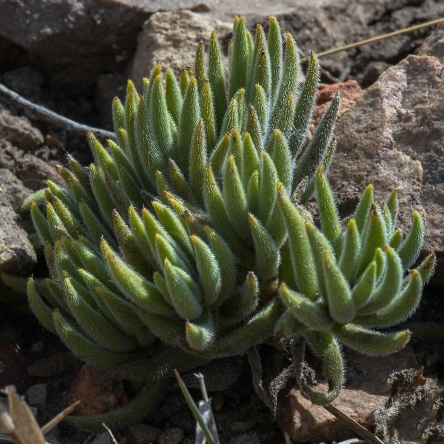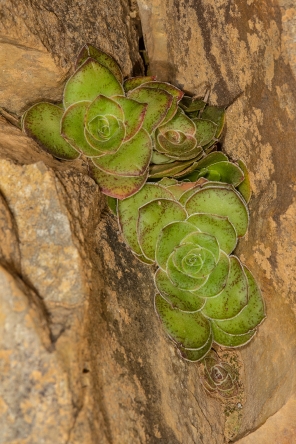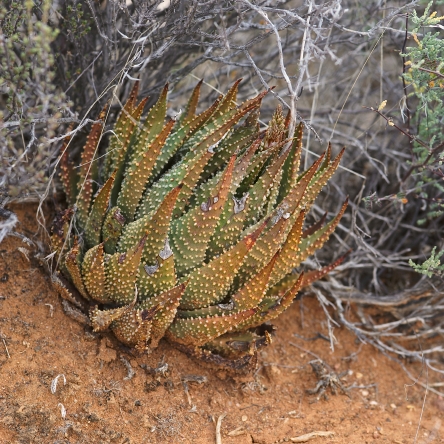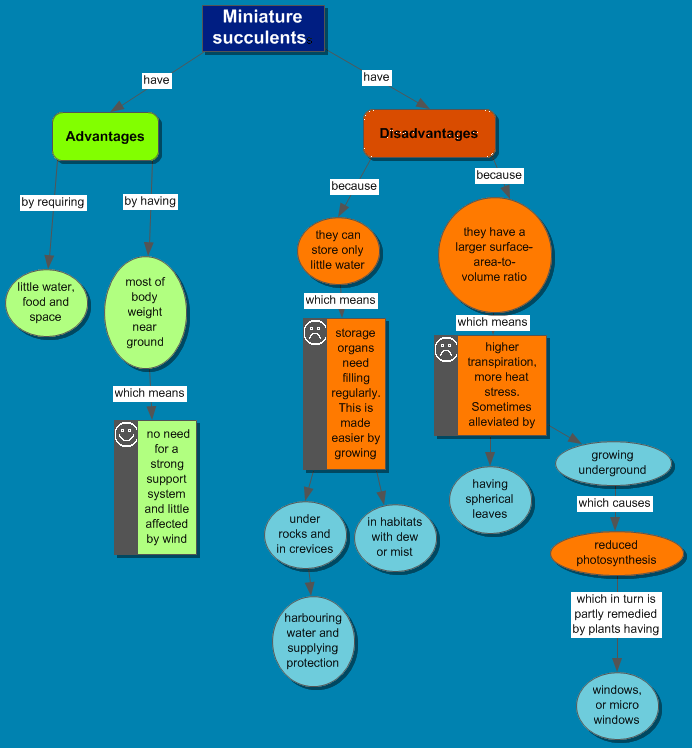It is probably safe to say that C. alstonii cannot be confused with any other plant species because of its unique appearance. The leaves are arranged in two rows and closely adpressed – at least in nature; in cultivation this is difficult to maintain. Each of the almost spherical rosettes is 2-5 cm in diameter.
The plants are found in northern Namaqualand, from just south of Lekkersing to near Komaggas, where they grow on low, gently sloping hills usually covered with quartzite gravel. This is a rather restricted distribution area, but in some places the plants are quite common.
Tag: Crassula
Crassula clavata
Usually the plants show the deep purplish red colours that you see here, in which case they are easy to recognize, but sometimes the leaves are green or yellowish green, making identification less straightforward.
As a rule the leaves are glabrous, but in the isolated Richtersveld populations they are softly hairy. Most of the populations occur in the mountains bordering the Karoo southwards towards Touwsrivier and Prince Albert, in rock crevices and shallow pockets of soil.
The flowers appear in September and October.
Crassula saxifraga
Another of the tuberous Crassulas, widespread from the Richtersveld to the Eastern Cape, in rock crevices (saxifraga means stone breaker) and on stony slopes. The tubers may be up to 9 cm across.
The white to dark pink flowers are relatively big (up to 7.5 mm long) and occur from April to June. The leaves usually appear after flowering.
Crassula hemisphaerica
Crassula atropurpurea v. cultriformis
One of the joys of looking for plants in the wild is the fact that you keep making new discoveries. Not earth-shattering ones, but things like a certain species in an unexpected place, an early flowering specimen or one that is much bigger than the ones you know, fruits you see for the first time etc.
Often you come across a plant which you can not identify but which is similar to ones you know, so you have some idea in what direction you should look to find out what it is. Especially when it has one or more striking characteristics, it is easy to convince yourself you will have no problem getting an ID, but sometimes you’re in for a surprise.
The subject of this post is a case in point.
When I saw the plants in the first two pictures, I was so taken by the beautiful and most unusual colour of the leaves that I supposed this aspect would quickly lead me to the proper name. Well, not quite.
For a while I thought they might represent an aberrant form of either C. nudicaulis or C. brevifolia, but the differences were too big.
It took me 3 years to get the right brainwave: throw the names “Crassula” and “Port Nolloth” at Google and see what it comes up with. And BINGO, there it was in a recent article in Avonia by my friend Gerhard Wagner from Berlin.
Amongst many other things he says the following:
“It is remarkable that H. R. Toelken in the Flora of Southern Africa (1985, p. 221) mentions extreme forms of C. atropurpurea v. cultriformis from the coastal area north of Holgat River with much smaller leaves. Such plants, with highly succulent, almost round leaves, we also found south of Port Nolloth at Mc Dougall’s Bay, almost on the beach. Including these plants in C. atropurpurea v. cultriformis seems strange and difficult to understand because of the great differences in habit. It is peculiar that these plants, although they are easily accessible and should be well known, have not been investigated more closely and hardly any mention of them has been made in the literature.”
The first two pictures were taken at McDougall’s Bay, 5 Sept. 2010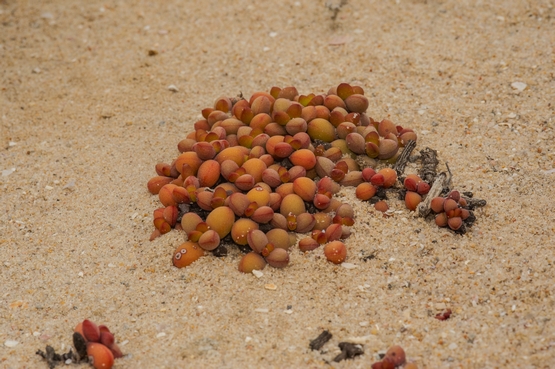
The next two are from the same place, 5 Oct. 2011
The last two were taken 8 Sept. 2010 and show the more conventional form of this variety in a more usual habitat (slopes with quartz gravel).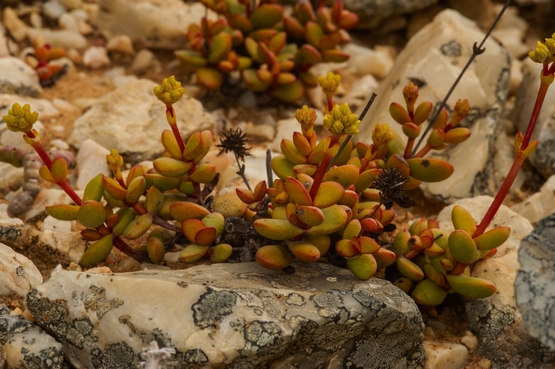
Crassula umbella
This is a member of an interesting little group of tuberous Crassulas. It occurs from the Richtersveld to the Little Karoo, usually on south-facing (shadowy) slopes under shrubs and especially under overhanging rocks.
The flowers appear in July to September and are described as star-shaped and white to yellowish green.
That is exactly as I always saw them in the wild, so that was the image that was imprinted on my brain.
A few weeks ago my wife and I went for a short drive in the area and to the northeast of town I found quite a few plants that looked like C. umbella but with rather different flowers.
The plants clearly belonged in the same group as C. umbella, so I looked up the relevant descriptions, but none of them fitted.
Obviously I had been to hasty, for when I started to reread the descriptions the problem was soon solved. The Flora of Southern Africa, vol. 14, by H. R. Toelken, says : “C. umbrella is a very variable species with several local forms ………………………………….
3. From Montagu westwards to near Worcester plants tend to have ovate corolla lobes with an acute to acuminate apex and slightly longer squamae. The somewhat larger flowers are cup-shaped and usually more or less turned downwards.”
As the following pictures show, this description fits the plants near Montagu to a T.
For the last picture I moved the camera slightly to get a darker background, so that the beautiful little flowers stand out better.
Crassula mesembryanthoides
Crassula pseudohemisphaerica
What’s in a name?
Like other names, a plant name is nothing more than a label, a way to refer to something or somebody, and to distinguish them from others.
Normally the name also gives you some extra information, but it is often unclear whether this is helpful or not. Let’s look at a few examples of this.
When you know that the Latin word pumilus means dwarf and you see that word as part of a plant name, you will expect that plant to be small, right? Well, yes …usually. There is a small plant in the Mesemb family called Antimima pumila. This is indeed a small plant, but so are most other Antimimas. The name only makes sense when you know that the plant used to belong in the genus Ruschia, where most plants are a lot bigger.
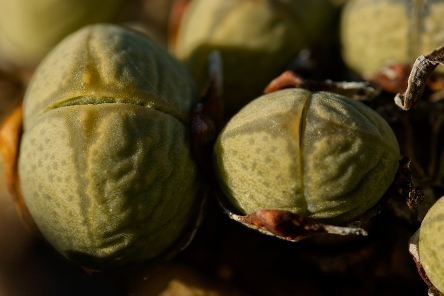
There are worse cases however. While on the topic of small members of a group, what about Haworthia minima and H. pumila? They must be among the smallest of Haworthias, one would think. But no, they are about the biggest. Very confusing, until you find out that these species first were considered to be Aloes and as such they were dwarfs of course.
There are many more examples of peculiar and confusing names, often as the result of transferring species from one genus to the other. What about Glottiphyllum linguiforme?

Glottis is Greek for tongue, phyllum comes from the same language and means leaf; lingua is Latin for tongue and forme means what you think it means. As long as the species was part of the super genus Mesembryanthemum the name was nice and descriptive, but nowadays it is more funny than anything else.
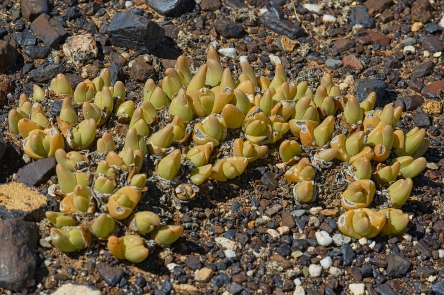
A similar case is Gibbaeum gibbosum, where both parts of the name refer to the Latin word for hump (gibba).
In several cases plants get their names from the geographical area where they were first found (Fockea capensis, Pachypodium namaquanum,) but is is a bit of an awkward practice. Sometimes the plant is later found to have a much wider distribution then thought at first (Aloe angolensis also occurs in Botswana, Namibia and Zambia, Avonia rhodesica is found not only in Zimbabwe- the former Southern Rhodesia- but also in South Africa and Botswana; etc.). The type material of Aloe littoralis was collected from a coastal area (near Luanda, Angola) and takes its name from that habitat. The distribution is now known to stretch right across the continent, so the name is rather misleading.
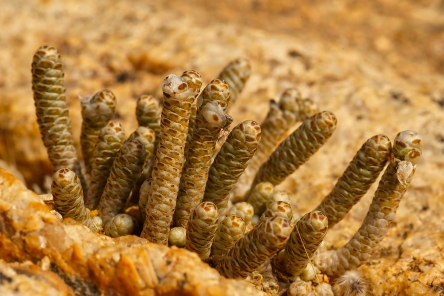
Avonia albissima is by no means the whitest species in the genus as the name implies.
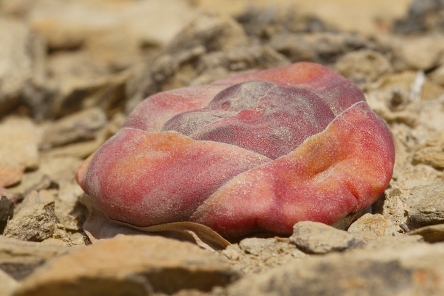
Crassula columnaris is usually anything but columnar.
A lot of plants have been named after people. Often this is the person who first found it (Tylecodon nolteei, Caralluma denboefii), which makes some sense, but sometimes the connection between plant and person is less obvious.
I remember the story of the Dutch horticulturalist J. A. Janse who was writing a book on succulents plants named after persons. Many of these names are of course well known, but after sifting through the literature he ended with a list of names that did not mean a thing to him.
One of the authors he approached for information was a distinguished French botanist who had described a couple of Kalanchoes from Madagascar.
After some time the botanist’s widow sent him a rather tart reply to his letter, in which she informed him that her husband has recently died and that the reason why nothing was known about these names, was that the ladies to which they referred had nothing to do with their namesakes, apart from the fact that at some stage they had been been her husband’s mistress.
The above should not lure you into thinking that the naming of plants is not a serious matter. It is, but to my mind a somewhat light-hearted approach to things can often make them just that little bit more interesting.
Miniature succulents, part 2
Succulent organs filled with water are quite heavy. In miniature succulents most of the body weight is near the ground, so that there is little or no need to build and maintain a strong support system. Because they are so compact, they are also far less exposed to external influences than other plants.
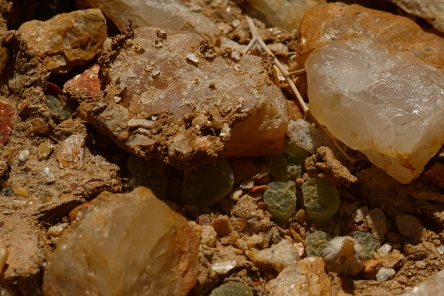
Plants like this Conophytum praesectum from near Pofadder are small enough to benefit from shade cast by pebbles
The fact that a great part of the plant is near to the soil has another -and rather unexpected- advantage. In the areas where succulents grow, wind is usually present and is often hot and strong. The continuous replacement of air around the plants has a dehydrating effect, so that evaporation can be extreme. Apart from this, the wind transports sand and dust, causing sand abrasion, which may damage the plants (especially seedlings) and remove hairs or wax cover.
Because of surface roughness, wind speed is zero at ground level, and wind becomes stronger with increasing height above the ground. It follows that the lower the plant, the less likely it will be to suffer from wind damage.
A drawback of being small is that smaller leaves and stems have a larger surface-area-to-volume ratio than large ones. As a result, their transpiration is relatively higher and they are more prone to heat stress. The fact that dwarf succulents have more or less spherical leaves or stems, helps to alleviate the problem. With regard to minimising evaporation, a sphere is the ideal shape, as it combines the minimum surface area with the maximum internal volume. (The surface area of a flat leaf is about 40 times bigger than that of a perfect globe with the same contents).
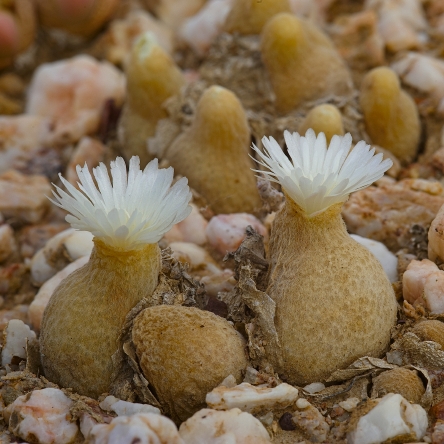
In the rare Muiria hortenseae from the southern Little Karoo, the two leaves making up each body are fused almost completely, so that the flowers have to force their way out
In some cases, pairs of leaves have grown into one, so that each pair resembles a little globe. Densely packed leaves or stems can attain similar results.
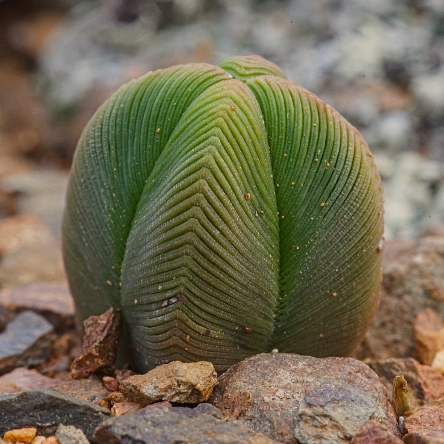
In Crassula pyramidalis the leaves fit so densely together, that it first sight the plant looks like a stem succulent rather than a leaf succulent
Water loss from the surface of the plant can further be minimised by (the plant) hiding underground. In dry periods, the plants are often completely hidden in the soil, covered with the sand and dust blown over them. Only when the bodies fill out at the beginning of the rainy period do they appear above ground again.
Experiments have shown that in Lithops the rate of water loss is about a fifth lower in plants that are embedded in the soil than in those totally exposed.
In addition, the daily variation of temperature in the leaves is reduced. This is important during the hottest part of the day, when the parts of the plant that are furthest away from the soil surface, stay cooler than those nearer the ground.
Hiding underground also has its disadvantages. Because less surface area is available, photosynthesis is much reduced, so growth is slowed down.
The famous window plants have found a way to reduce this problem. These plants occur almost exclusively in the dry winter rainfall areas of southern Africa and are found in just a few families- most commonly the vygies (Aizoaceae, several genera). Other examples are Haworthia and Bulbine.

Haworthia truncata has a limited distribution area around Calitzdorp and Oudtshoorn. It is one of a number of Haworthias with windows
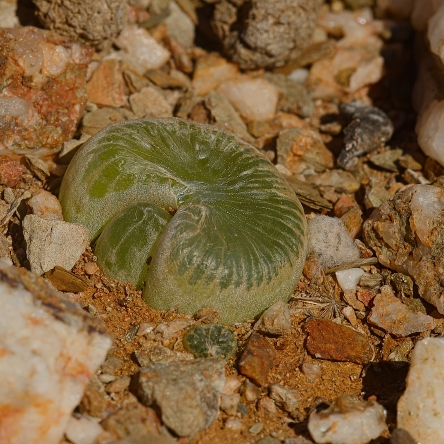
A perfect specimen of waterglasie (Bulbine mesembryanthoides)
The classic example is Fenestraria rhopalophylla: The plants are practically stem less and have club-shaped leaves with a translucent area on top.
As only a small part of the leaves is exposed to light, photosynthesis would normally be seriously hampered. The window at the top however, combined with translucent water-storage cells deeper inside the leaf, makes it possible for light to penetrate into the leaf and reach the inside of its mantle. Here, (there) are cells that contain chlorophyll and make photosynthesis possible.
The plants grow in the mist zone on the coast of northern South Africa and southern Namibia where the leaves are drawn into the ground by thick contractile roots. Usually the plants grow in deep sand, but sometimes they are found in pockets above dolomite rocks. Although the plants are only a few centimeters across, the root system may cover up to 2 metres. The mat of fine roots just underneath the surface is able to absorb the condensation of the moisture brought in by the sea fog, which is the main source of water for these plants.
The leaves are usually flush with the sand so that they do not suffer from the strong winds that blow almost daily.
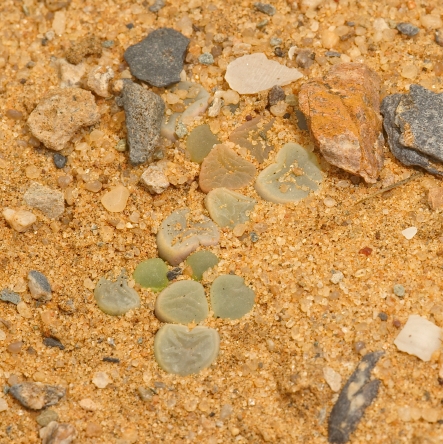
This F. rhopalophylla ssp. aurantiaca was photographed south of Port Nolloth, in close proximity to the sea
The so-called stone plants – among the smallest flowering plants in the world- have followed a slightly different route. They have very thick leaves, often with dark green dots in their leaf tops. These dots contain no pigment and may be either large single cells or a group of smaller ones. They lie just below the epidermis and serve as micro windows, which may take up to over 40% of the leaf surface. In winter, when the sunlight is weak, the non-pigmented zones help it to penetrate into the leaves.
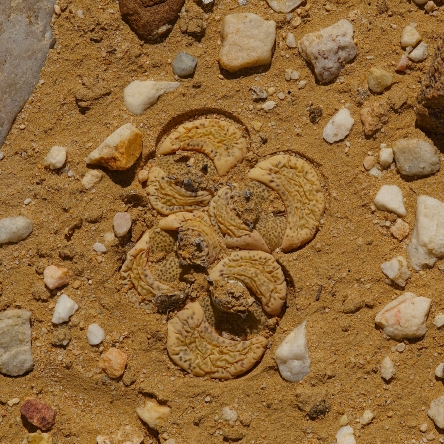
Lithops localis near Prince Albert, showing its many micro windows
A peculiar adaptation is shown by many members of the mesemb family (Aizoaceae), especially the dwarf ones, which are able to recycle water from old leaves to new ones.
This phenomenon was already discussed in an earlier post (Water recycling in succulents, 4th Dec. 2012), so please have a look there if you are interested.
In this article, I have tried to highlight some of the intriguing adaptations miniature succulents deploy in order to survive. Of course, these are only a few of the techniques and strategies they have in common with other succulents. But that is another story, for another day.
***
The original version of this article appeared in the most recent issue of Veld & Flora (March 2013). If you are interested in the immensely rich flora of South Africa, it is well worth visiting their website: www.botanicalsociety.org.za.
***
Since I wrote the article I acquired a new piece of software (Inspiration) which allows the user to make mind maps, concept maps, flow charts etc. in a very intuitive and easy way. I had tried out similar programs before, but never liked the results, nor the way they worked. To my mind, this program scores well on both points.
As I am currently working on a book on how succulents survive in the wild, I thought it might be helpful to use a diagram such as the one below, to make complicated processes and relations a bit clearer.
It would be great if readers would have a critical look at this diagram and tell me if it works for them. Many thanks in advance!
